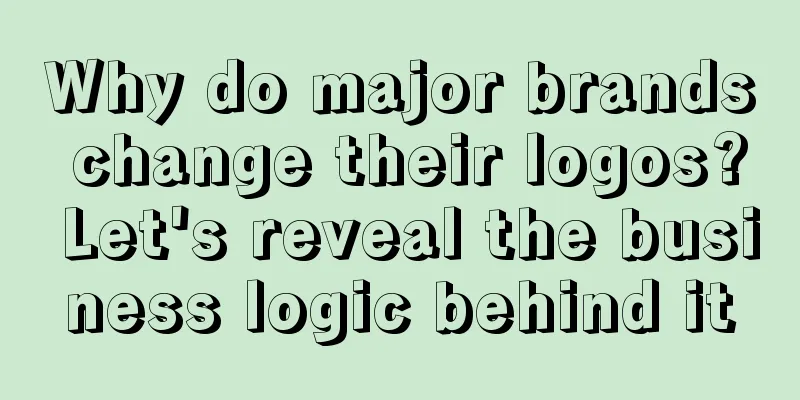Why do major brands change their logos? Let's reveal the business logic behind it

In the past two years, from Heytea to Nayuki, from Xiaomi to Nokia, all walks of life have been swept by a wave of "changing logos". According to statistics, hundreds of brands changed their logos in the past year alone. However, many brands’ new logos have not been widely recognized by consumers, but have instead sparked complaints and criticism. Some brands’ new logos are no better than their old ones, while some brands’ changes are minimal. In this situation, why do brands still risk challenging consumers’ perception by upgrading their logos? What is the logic behind this? To answer these questions, first we need to understand the importance of logo to brand. 1. Logo is the company’s “first business card”As the "first business card" for a company to reach consumers, the logo is undoubtedly an extremely important business card. Firstly, a logo is highly recognisable and identifiable , and is the visual identity of a brand, which can help consumers quickly identify and recognise the brand, and help differentiate the brand from its competitors. Secondly, logo is an important part of brand image . A good logo can convey the brand’s values, personality and characteristics, trigger emotional resonance among consumers, and establish an emotional connection between the brand and consumers. Finally, logos help to enhance user trust and the professional image of a company. A well-designed logo can convey the professionalism, reliability, and stability of a brand. It builds trust and goodwill among potential customers. Of course, there may be some unexpected surprises. For example, in 2021, Xiaomi spent 2 million to change its new logo. At that time, it caused ridicule among netizens, saying that the new logo was just a square-shaped logo that changed the old logo into a round one, and many people sympathized with Lei Jun for being cheated of 2 million. In fact, in the eyes of many netizens, this design, which is so simple that ordinary people can complete it in a few seconds using PPT, is the work of Japanese design master Kenya Hara. Of course, what Kenya Hara sold to Lei Jun was not just a logo, but a complete set of VI (corporate visual identification system). In other words, in addition to the logo, it also includes standard characters, standard colors, logo and standard character combination, etc. This is a complex project. Looking back now, there is nothing wrong with making minor adjustments to the logo. More importantly, this incident was also on the hot search list many times at the time, and the related topics on Weibo were read nearly 350 million times. From a marketing perspective, the 2 million was definitely worth it. 2. Why do brands change their logos so frequently?Usually, a brand changes its logo not on a whim, but with a clear purpose. It either serves the needs of brand marketing, strategic change, or business upgrade. In the current rapidly changing consumer market, brand logo adjustments are more frequent. Below, I summarize 3 common reasons for brand logo changes from some typical brand logo upgrade cases. 1. Product style changesSometimes, the reason for a brand to change its logo can be very simple, such as a company changing its "boss". In March 2018, former Givenchy creative director Richard Tiss joined Burberry as creative director. In the same year, Burberry announced the launch of a new logo, the first time the brand has changed its logo since 1999, replacing Burberry's classic knight pattern with a flatter and more modern sans serif font. This logo change is also seen as the beginning of a new era for the brand. 2. Brand business expansionThere is another situation that will prompt a brand to decide to change its logo, and that is the expansion of the company's business. In January 2011, Starbucks revamped its logo, removing the classic Starbucks Coffee words and replacing them with a planned Siren pattern, and the background color of the pattern changed from black to green. In response, Starbucks explained that as the company develops, it will no longer be limited to operating coffee shops, and will try to launch non-coffee products such as ice cream and bottled Frappuccino. In this context, the original logo could not carry the brand's latest business, so the decision was made to change the logo. Coincidentally, when Meitu XiuXiu version 8.0 was updated in 2018, it also brought the brand's latest logo. In its early days, Meitu was a free image processing software. As the number of users grew, it launched the "Social Circle" function to encourage everyone to post interesting photos and provide users with a richer social experience. 3. Cater to the public aestheticWith the rise of Generation Z, young consumers have become a force that cannot be ignored. To cater to the preferences of young people, more and more brands are beginning to adapt to the times and change their logos to cater to current aesthetics. In 2018, in order to innovate its brand image, Yili reduced the three "crescents" surrounding the word "Yili" in the logo to two, and removed the sunshine element originally located in the upper right corner. In terms of font, the word "Yili" is more rounded and flat, making the overall logo more in line with the aesthetic trends of the new generation of consumers. In addition to Yili, the video website iQiyi also decided to change its logo. In April 2022, iQiyi announced the release of a new logo on its 12th anniversary. By comparison, it is not difficult to see that the new logo has removed the border design, the font layout is more stretched, and the color saturation of the new version is high, so it looks quite vibrant. It is worth mentioning that although logo upgrade seems simple, it also has certain risks. If you are not careful, it may even cause a public relations crisis. For example, in 2010, GAP wanted to replace its logo with a more modern one, which was created in 1969. However, this unexpected decision turned into a public relations disaster. As a casual clothing brand deeply rooted in the hearts of Americans, many loyal customers expressed their dissatisfaction with the new logo on the Internet. Not long after, Gap finally decided to withdraw the new logo and continue to use the previous classic logo. Therefore, when upgrading a brand’s logo , one must not only keep up with the latest trends, but also consider the possible impact of the changes on customers. How can a brand create a “hot-selling logo”? 3. Why are some logos unforgettable, while others are hard to remember?How should brands create an eye-catching and popular logo in a market with fierce competition and increasing homogeneity? You can refer to the following five design principles: 1. Reflect brand positioningThe quality of a logo is not only reflected in the beauty of its design, but also in whether it can accurately reflect the brand positioning. For example, the logo of Toutiao has its core business embedded in the pattern, allowing users to understand at a glance that this is a software dedicated to news and information. 2. Highly recognizableThe logo is the symbol of the brand, and the brand hopes to strengthen the user's recognition of the brand through the logo. To some extent, the logo plays a role of differentiation, so a highly recognizable logo is very necessary. For example, Apple's logo is an apple that is familiar to people all over the world. But it is not an ordinary apple, but an apple with a bite taken out of it. This detailed design enhances the brand's imagination and makes users who have seen the Apple logo remember it forever. 3. Conform to current aestheticsThe public aesthetic is not static, but constantly changing. In the early years, the Japanese style was highly praised in the market. Therefore, brands such as Yuanqi Forest and Nayuki Tea packaged themselves as "pseudo-Japanese brands". As the myth of Japanese manufacturing has been shattered in the hearts of the Chinese people, Chinese manufacturing has become the new trend. In this context, Nayuki’s new logo abandoned the Japanese style and changed “Nayuki’s Tea” into “Nayuki’s Tea”. The English word next to it was also replaced with Nayuki’s Chinese pinyin, showing a Chinese brand’s cultural confidence. 4. Convey value conceptsFor a brand, the image or shape used in the logo should preferably represent the brand itself or its values. A good symbol can make the brand more vivid and convey more information. For example, Nike’s logo was inspired by the feathers on the wings of the Greek goddess of victory. The simple and powerful hook shape reminds people of the speed, dynamism and explosiveness required for sports. 5. Follow minimalismNowadays, minimalism has become a trend. More and more brands are simplifying their logos, emphasizing flat and simple shapes. For example, the latest logo released by Heytea in 2022 incorporates the popular "minimalism" in design, and the details make the icon look more simple and elegant. Of course, if you want a logo to "go viral" or receive positive reviews, it depends on many factors, and it also tests the company's ability to respond and overall strength. 4. Final ThoughtsAs for the importance of brand logo, Steve Jobs once gave the answer in 1993. It takes at least "ten years and $100 million" to make consumers associate the logo with the brand. For brands, changing the logo is certainly a way to attract attention and show brand strength. However, the creation of a brand image still requires time to accumulate and settle. Only when the company's strength improves and its logo keeps pace with the times can a brand image that is deeply rooted in the hearts of the people be created. Author: Yan Tao Source: WeChat public account "Yan Tao Sanshou (ID: yantao-219)" |
<<: With Luckin Coffee’s 10,000 stores, is Mixue Ice City getting an enemy or a comrade?
Recommend
With 2.5 billion topic views, how did "Wumeizijiang" brainwash the entire network?
Recently, I believe that you who watch videos have...
Master these 15 marketing strategies to make your sales soar
In a highly competitive business environment, effe...
Can I only cancel my cross-border e-commerce account once? How do I register for a cross-border e-commerce account?
In the process of cross-border e-commerce industry...
Announcement on Wish and Qoo10 sales integration
Qoo10’s acquisition of Wish has now been completed...
One live broadcast attracted millions of viewers, and the number of followers increased by over 100,000 in a single month. Is Xiaohongshu's content live streaming the next trend?
Xiaohongshu content live streaming is becoming a n...
Nearly 10,000 people have fun at this lonely shop
A Taobao store selling poems attracts many custome...
WeChat Store APP is online!
The launch of the WeChat Store APP marks an import...
What materials do you need to prepare to open a store on Amazon US? How can you prepare?
Amazon has many sites. If you want to open a store...
Xiaohongshu has small ambitions, but local businesses are getting anxious
In order to turn losses into profits, Ele.me has b...
How to register a Facebook email address? How to register a Facebook email address
As one of the world's largest social media pla...
Full scale, more delicious than Zibo barbecue
Zibo barbecue has been all over the internet recen...
Douyin joins the e-commerce platform "Hourly Delivery", and instant delivery is open!
In today's fierce competition among e-commerce...
This time, the user segmentation model was finally evaluated as [useful]
What is the user grouping model? What substantive ...
The value and significance of brand user portraits
User portrait is an important way to achieve preci...
Can Amazon sell virtual items? Is it easy to sell virtual items?
The profit margin of physical products is actually...









